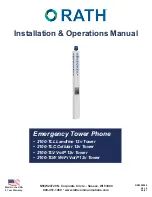
5-7
Cisco Unified IP Phone 7960G and 7940G Administration Guide for Release 8.0 (SIP)
OL-7890-01
Chapter 5 Monitoring Cisco SIP IP Phones
How to Use the Command-Line Interface to Monitor Phones
Output Examples
Phone Status
The following sample output shows that the proxy servers are not configured:
Phone1>
show status
Current Phone Status
------------------------------
W351 unprovisioned proxy_emergency
W350 unprovisioned proxy_backup
Telnet Session
The following sample output shows the initial Telnet session using a UNIX server:
UNIX%
telnet 10.18.10.10
Trying 10.18.10.10...
Connected to 10.18.10.10.
Escape character is '^]'.
Password :*****
SIP Phone>
traceroute
ip-address
[
ttl
]
Initiates a traceroute session from the console or from a Telnet
session. Traceroute shows the route that IP datagrams follow
from the SIP IP phone to the specified IP address. The
arguments are as follows:
•
ip-address
—Dotted IP address or alphanumeric address
(host name) of the host to which you are sending the
traceroute.
•
ttl
—(Optional) Time-to-live value or the number of
routers (hops) through which the datagram can pass.
Default is 30.
SIP Phone>
tty
{
echo
{
on
|
off
}
|
mon
|
time
value
|
kill
session
|
msg
|
prompt
}
Controls the Telnet system. Arguments and keywords are as
follows:
•
echo
—Controls local echo. Valid values are on and off.
•
mon
—Sends all debug output to both the console and the
Telnet sessions.
•
time
value
—Sets the Telnet session timeout period, in
seconds. Range is from 0 to 65535.
•
kill
session
—Tears down the Telnet session specified by
the
session
argument.
•
msg
—Sends a message to another terminal logged into
the phone; for example, you can send a message telling
everyone else that is logged in to log off.
•
prompt
—Changes the prompt for a TTY session.
Table 5-1
CLI Commands (continued)
Command
Purpose
















































